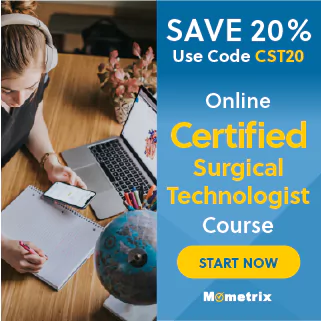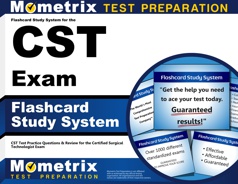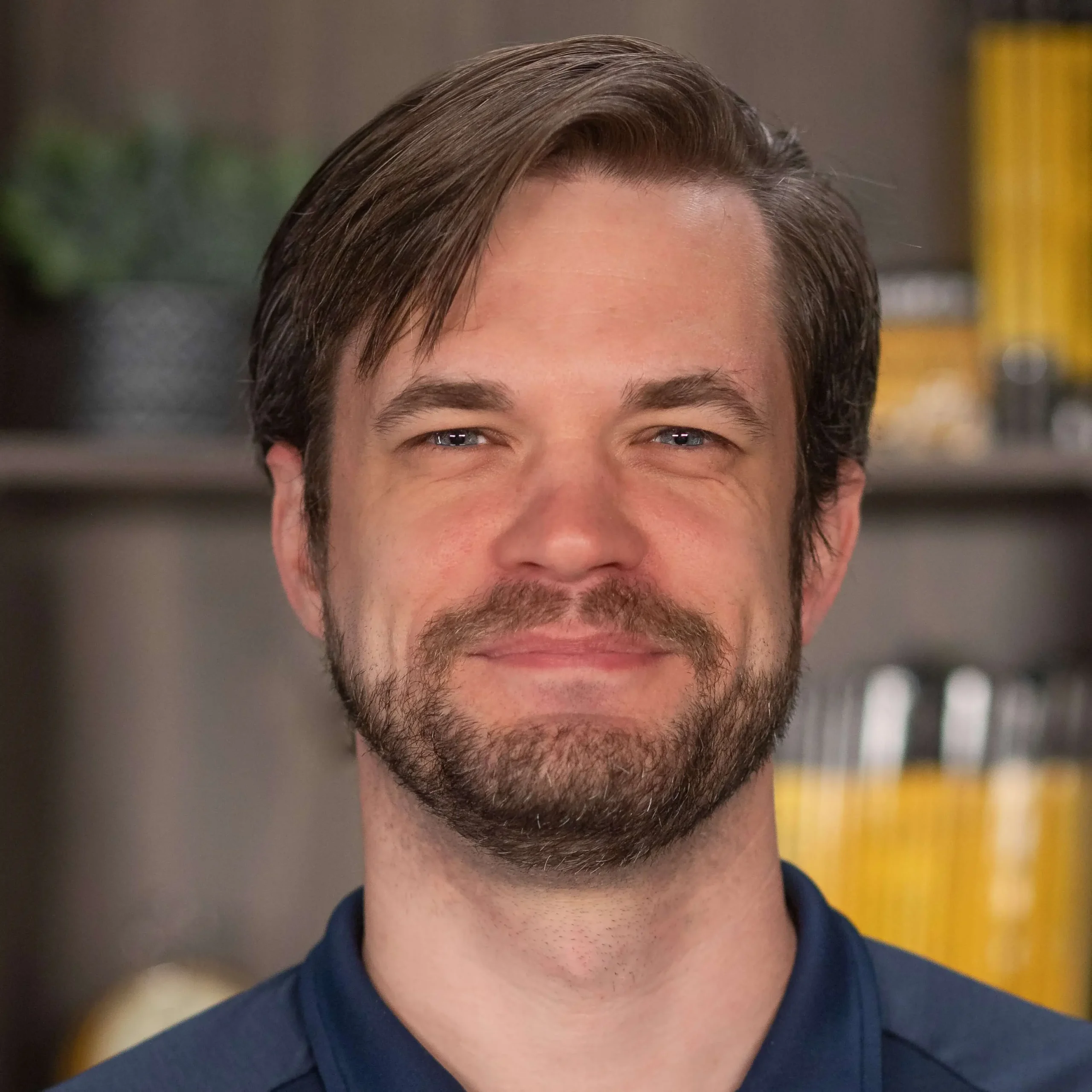The National Board of Surgical Technology and Surgical Assisting (NBSTSA) provides the Certified Surgical Technologist (CST) certification exam for professionals who seek to demonstrate expertise in aseptic technique, patient care, and surgical procedures. The CST certification gives professionals the opportunity to increase their income, earn higher-level positions, and gain nationwide recognition.
Click “Start Test” above to take a free CST practice test!
CST Exam Eligibility
To qualify for the CST exam, you must follow one of two routes of eligibility: graduating from a surgical technology program or graduating from a military training program in surgical technology.
The program you were enrolled in must have been ABHES- or CAAHEP-accredited while you were enrolled. To prove eligibility, you must provide ONE of the following documents:
- A copy of your graduation certificate
- Unofficial or official transcript
- A notarized letter from the program director which includes your name, date of graduation, and the degree information
Route 2: Completion of a Military Training Program in Surgical Technology
Eligible programs must have had CAAHEP accreditation before, during, or after your enrollment. To prove eligibility, you must submit ONE of the following documents:
- A copy of your graduation certificate
- A copy of your DD214, which includes the state the program was completed
- A SMART or Joint Service transcript
CST Exam Outline
The CST exam contains 175 multiple-choice questions, 25 of which are unscored, and you will be given 4 hours to complete the exam.
The 25 unscored questions are called “pretest” questions, and they are used to evaluate questions for future versions of the exam. You won’t know which questions are pretest questions, as they are mixed in with the scored questions throughout the exam.
The exam is split into three domains.
I. Perioperative Care (91 questions)
The questions in this domain test your knowledge and skills in various aspects of the perioperative care process. There are three main topics covered in this domain:
- Preoperative Preparation (18 questions): Some of the things you will be asked to do are verify the availability of surgical equipment, perform a medical hand wash, transfer a patient to and from the operating room, and participate in Universal Protocol.
- Intraoperative Procedures (61 items): Some of the things you will be asked to do are maintain aseptic technique throughout a procedure, perform counts with the circulator at appropriate levels, monitor medication and solution use, and assist in applying casts, splints, and braces.
- Postoperative Procedures (12 items): Some of the things you will be asked to do are participate in a case debrief, dispose of contaminated waste and drapes, transfer a patient from the operating table to a stretcher, and perform room cleanup duties.
II. Ancillary Duties (26 questions)
The questions in this domain test your knowledge and skills regarding various ancillary duties. There are two main topics covered in this domain:
- Administrative and Personnel (9 questions): Some of the things you will be asked to do are follow the proper cost containment processes, understand basic electricity safety principles, use interpersonal skills, and serve as a preceptor to perioperative personnel.
- Equipment Sterilization and Maintenance (17 questions): Some of the things you will be asked to do are troubleshoot equipment malfunctions, inspect and assemble equipment and instruments, sterilize instruments, and package equipment and instruments.
III. Basic Science (33 questions)
The questions in this domain test your knowledge of basic science processes and terminology. There are three main topics covered in this domain:
- Anatomy and Physiology (20 questions): Some of the things you will be asked to do are correctly use medical terminology and abbreviations, demonstrate knowledge of various anatomical systems, and identify various surgical pathologies.
- Microbiology (6 questions): Some of the things you will be asked to do are apply surgical microbiology principles to operative practice and address factors that can influence an infectious process.
- Surgical Pharmacology (7 questions): Some of the things you will be asked to do are apply surgical pharmacology principles to operative practice and maintain dosage awareness.
Check Out Mometrix's CST Study Guide
Get practice questions, video tutorials, and detailed study lessons
Get Your Study Guide
CST Exam Registration
To register for the CST exam, you must ensure you meet the requirements and then send in an application, which can be done online or by mail. You will also need to send the examination fee, which is $190 for AST members and $290 for non-members.
After your application is approved, you will receive an Authorization To Test (ATT). You must then schedule your exam before the expiration date, which is stated in the ATT. During this time, you will be able to choose whether you take the exam in-person at a testing center or remotely via an online proctor.
Online Certified Surgical Technologist Prep Course
If you want to be fully prepared, Mometrix offers an online Certified Surgical Technologist Prep Course. The course is designed to provide you with any and every resource you might want while studying. The Certified Surgical Technologist Course includes:
- Review Lessons Covering Every Topic
- 700+ Certified Surgical Technologist Practice Questions
- More than 400 Digital Flashcards
- Money-back Guarantee
- Free Mobile Access
- and More!
The Certified Surgical Technologist Prep Course is designed to help any learner get everything they need to prepare for their Certified Surgical Technologist (CST®) exam. Click below to check it out!

Test Day
Depending on which testing method you chose during registration, your test day will look a little different.
In-person Testing
You should arrive at the testing center 15-30 minutes before your scheduled appointment time. During the check-in process, you will be asked to provide two forms of valid ID, one of which must contain your photo. Valid forms of ID include your driver’s license, state ID card, passport, and military ID card. If you cannot provide both forms of ID, you will not be permitted to take the exam that day.
Before you enter the testing room, you will be asked to leave all personal items behind, such as books, notes, pencils, weapons, your cell phone, and any valuables.
Once you enter the testing room, you will be given the opportunity to take a practice exam on the computer, which will not take away from the exam time and will not affect your score in any way. This is just to help you become familiar with the computer and the testing software.
Once you have completed the test, you will be provided with a preliminary pass/fail report.
Remote Testing
You should log in to your account 15-30 minutes before the scheduled exam time. Once you have logged in, you will be asked to perform a system check to ensure your equipment and internet connection are adequate.
After the system check is complete, the proctor will verify your identity and ask you to scan your environment with your webcam. Once the proctor is satisfied that you are ready, the exam will begin.
Once you have completed the test, you will be provided with a preliminary pass/fail report.
How the CST Exam is Scored
Regardless of the testing method, you will receive a preliminary pass/fail report as soon as you finish your exam. An official score report will be sent to you approximately 2 weeks after the exam is taken.
To pass the exam, you will need to answer at least 102 of the 150 scored questions correctly.
Check Out Mometrix's CST Flashcards
Get complex subjects broken down into easily understandable concepts
Get Your Flashcards
How to Study for the CST Exam
How to Study Effectively
Your success on CST test day depends not only on how many hours you put into preparing but also on whether you prepared the right way. It’s good to check along the way to see whether your studying is paying off. One of the most effective ways to do this is by taking CST practice tests to evaluate your progress. Practice tests are useful because they show exactly where you need to improve. Every time you take a free Certified Surgical Technologist exam practice test, pay special attention to these three groups of questions:
- The questions you got wrong
- The ones you had to guess on, even if you guessed right
- The ones you found difficult or slow to work through
This will show you exactly what your weak areas are and where you need to devote more study time. Ask yourself why each of these questions gave you trouble. Was it because you didn’t understand the material? Was it because you didn’t remember the vocabulary? Do you need more repetitions on this type of question to build speed and confidence? Dig into those questions and figure out how you can strengthen your weak areas as you go back to review the material.
Answer Explanations
Additionally, many CST practice tests have a section explaining the answer choices. It can be tempting to read the explanation and think that you now have a good understanding of the concept. However, an explanation likely only covers part of the question’s broader context. Even if the explanation makes sense, go back and investigate every concept related to the question until you’re positive you have a thorough understanding.
Comprehend Each Topic
As you go along, keep in mind that the CST practice test is just that: practice. Memorizing these questions and answers will not be very helpful on the actual test because it is unlikely to have any of the same exact questions. If you only know the right answers to the sample questions, you won’t be prepared for the real thing. Study the concepts until you understand them fully, and then you’ll be able to answer any question that shows up on the test.
Strategy for CST Practice
When you’re ready to start taking practice tests, follow this strategy:
- Remove Limitations. Take the first test with no time constraints and with your notes and Certified Surgical Technologist study guide handy. Take your time and focus on applying the strategies you’ve learned.
- Time Yourself. Take the second practice test “open book” as well, but set a timer and practice pacing yourself to finish in time.
- Simulate Test Day. Take any other practice tests as if it were test day. Set a timer and put away your study materials. Sit at a table or desk in a quiet room, imagine yourself at the testing center, and answer questions as quickly and accurately as possible.
- Keep Practicing. Keep taking practice tests on a regular basis until you run out of practice tests or it’s time for the actual test. Your mind will be ready for the schedule and stress of test day, and you’ll be able to focus on recalling the material you’ve learned.
FAQs
Q
How many questions are on the CST exam?
A
There are 175 multiple-choice questions on the exam.
Q
How long is the CST exam?
A
The time limit for the exam is 4 hours.
Q
What is the passing score for the CST exam?
A
You must answer 102 of the scored questions correctly to pass the exam.
Q
How much does the exam cost?
A
The examination fee is $190 for AST members and $290 for non-members.
Q
Can you take the CST exam without going to school?
A
To be eligible for the CST exam, you must either have graduated from a surgical technology program or from a military training program in surgical technology.


